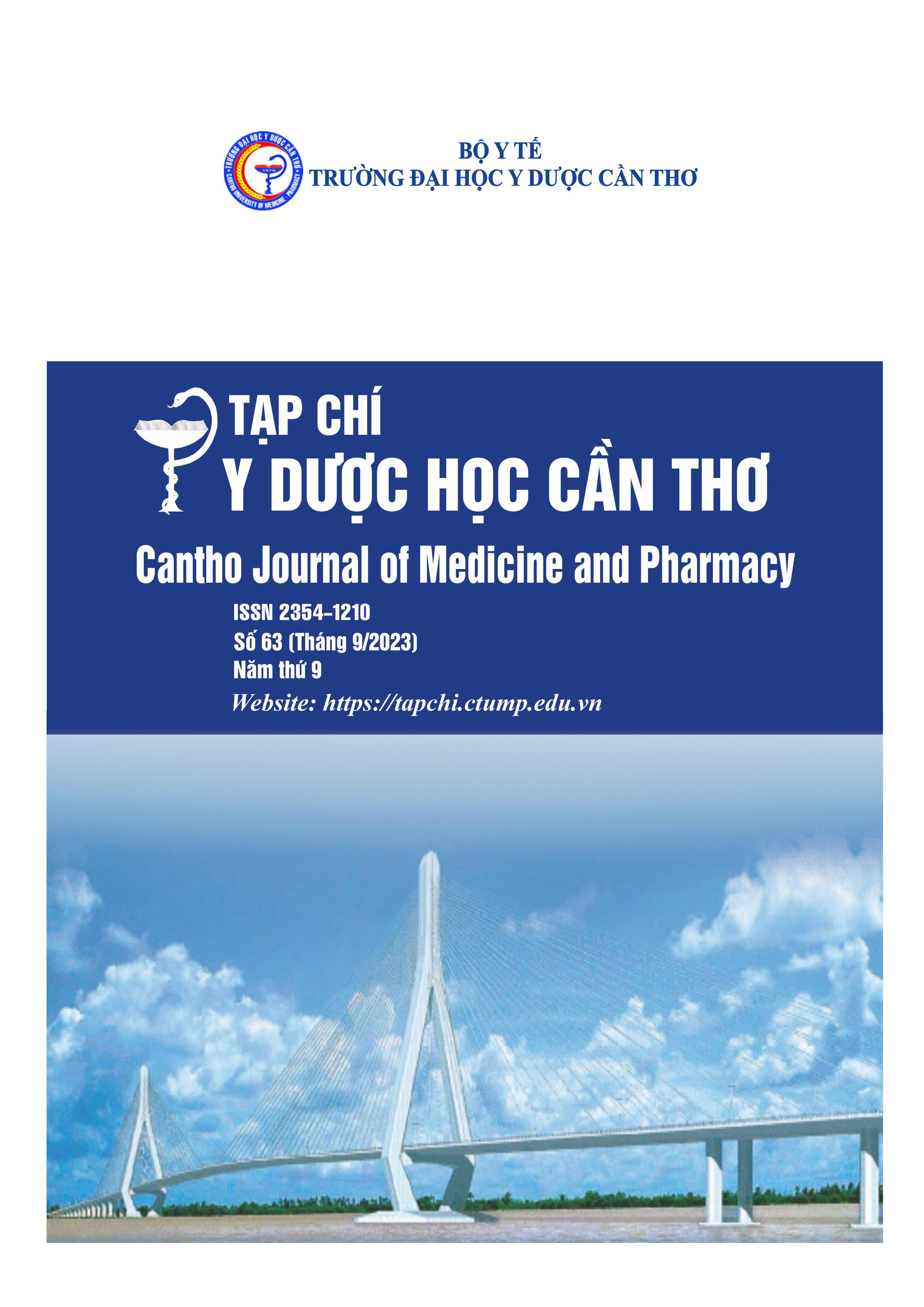ENDOSCOPY TIMINGS AND THE RESULTS OF THE TREATMENT OF PEPTIC ULCER BLEEDING AT CAN THO CENTRAL GENERAL HOSPITAL IN 2022-2023
Main Article Content
Abstract
Background: Upper Gastrointestinal Endoscopy is an accurate method of diagnosing the site of bledding from peptic ulcers and has a high hemostatic effect. However, the timing of endoscopy in patients with acute upper gastrointestinal hemorrhage remains controversial. Objectives: (1) To survey endoscopy timings and some factors related to treatment in patients with gastrointestinal bleeding due to peptic ulcer; (2) To evaluate of treatment results according to the endoscopy timings. Materials and methods: A prospective, cross-sectional study was conducted on 239 patients with peptic ulcer bleeding admitted in Can Tho Central General Hospital from August
2022 to April 2023. Results: Urgent endoscopy (< 12 hours) 21.76%, early endoscopy (12-24 hours) 16.32%, delayed endoscopy (> 24 hours) 61.92%; there was revalant associated with units of blood transfused, ulcer size, length of hospital stay and the general treatment results (p<0.05). The rate of patients receive endoscopic hemostasis were 64.85%, the rate of general successful initial hemostasis was 96.13%, the initial hemostasis failure only occurred with delayed endoscopy 6.45%. The general rate of recurrent bleeding was 10.74%. The rate of success treatment results with urgent endoscopy was 96.15%, early endoscopy was 97.44% and delayed endoscopy was 85.14%. The general success treatment results were 89.54%. Conclusion: Urgent endoscopy (<12 hours) and early endoscopy (12-24 hours) of presentation should be performed in patients admitted with peptic ulcer bleeding, providing a high benefit in clinical outcomes and hospitalization expenses.
Article Details
Keywords
Peptic ulcer bleeding, Upper Gastrointestinal Endoscopy, endoscopy timing
References
2. Rotondano G. Epidemiology and diagnosis of acute nonvariceal upper gastrointestinal bleeding. Gastroenterol Clin North Am. 2014. 43(4), 643-63, DOI: 10.1016/j.gtc.2014.08.001.
3. Quách Trọng Đức, Đào Hữu Ngôi, Đinh Cao Minh, Nguyễn Hữu Chung, Hồ Xuân Linh và cộng sự. Khảo sát tình hình điều trị xuất huyết tiêu hoá trên không do tăng áp tĩnh mạch cửa tại một số bệnh viện lớn. Y Học TP Hồ Chí Minh. 2015. 19(1), 74-79.
4. Barkun A. N., Almadi M., Kuipers E. J., Laine L., Sung J., et al. Management of Nonvariceal Upper Gastrointestinal Bleeding: Guideline Recommendations From the International Consensus Group. Ann Intern Med. 2019. 171(11), 805-822, DOI: 10.7326/m19-1795.
5. Laine L., Barkun A. N., Saltzman J. R., Martel M., Leontiadis G. I. ACG Clinical Guideline: Upper Gastrointestinal and Ulcer Bleeding. Am J Gastroenterol. 2021. 116(5), 899-917, DOI:
10.14309/ajg.0000000000001245.
6. Götz M., Anders M., Biecker E., Bojarski C., Braun G., et al. S2k Guideline Gastrointestinal Bleeding - Guideline of the German Society of Gastroenterology DGVS. Z Gastroenterol. 2017. 55(9), 883-936, DOI: 10.1055/s-0043-116856.
7. Gralnek I. M., Stanley A. J., Morris A. J., Camus M., Lau J., et al. Endoscopic diagnosis and management of nonvariceal upper gastrointestinal hemorrhage (NVUGIH): European Society of Gastrointestinal Endoscopy (ESGE) Guideline - Update 2021. Endoscopy. 2021. 53(3), 300-332, DOI: 10.1055/a-1369-5274.
8. Mullady D. K., Wang A. Y., Waschke K. A. AGA Clinical Practice Update on Endoscopic Therapies for Non-Variceal Upper Gastrointestinal Bleeding: Expert Review. Gastroenterology. 2020. 159(3), 1120-1128, DOI: 10.1053/j.gastro.2020.05.095.
9. Nguyễn Đình Bảo Long. Đánh giá kết quả điều trị ở bệnh nhân xuất huyết tiêu hoá do loét dạ dày tá tràng tại Bệnh viện Đa khoa Trung ương Cần Thơ năm 2020-2021. Trường Đại học Y Dược Cần Thơ. 2021. 113.
10. Huỳnh Hiếu Tâm, Hoàng Trọng Thảng. Hiệu quả của tiêm cầm máu qua nội soi bằng dung dịch HSE 3% ở bệnh nhân xuất huyết tiêu hoá do loét dạ dày tá tràng phối hợp với thuốc ức chế bơm proton liều cao. Tạp chí Y Dược học - Trường Đại học Y Dược Huế. 2014. (22+23), 36-39.
11. Trần Văn Huy, Đinh Duy Liêu. Nghiên cứu kết quả điều trị cầm máu bằng kẹp clip kết hợp với Esomeprazole tĩnh mạch ngắt quãng ở bệnh nhân loét dạ dày tá tràng chảy máu. Tạp chí Y Dược học - Trường Đại học Y Dược Huế. 2019. 9(2), 40-44, https://www.doi.org/10.34071/jmp.2019.2.7
12. Phạm Thị Hồng Điệp. Nghiên cứu đặc điểm lâm sàng, cận lâm sàng và đánh giá kết quả kẹp cầm máu điều trị xuất huyết tiêu hoá do loét dạ dày - tá tràng. Trường Đại học Y Dược Cần Thơ. 2017. 117.
13. Hoàng Văn Chương, Nguyễn Thanh Nam, Nguyễn Công Long. So sánh kết quả cầm máu bằng kẹp clip và kẹp clip kết hợp với tiêm cầm máu ở bệnh nhân xuất huyết tiêu hoá do loét dạ dày - tá tràng. Tạp chí Y Học Việt Nam. 2023. 526(1A), 121-125, https://doi.org/10.51298/vmj.v526i1A.5304
14. Romstad K. K., Detlie T. E., Søberg T., Thomas O., Ricanek P., et al. Treatment and outcome of gastrointestinal bleeding due to peptic ulcers and erosions - (BLUE study). Scand J Gastroenterol. 2022. 57(1), 8-15, DOI: 10.1080/00365521.2021.1988701.
15. Huỳnh Hiếu Tâm, Hoàng Trọng Thảng. Nghiên cứu hiệu quả của kẹp cầm máu qua nội soi ở bệnh nhân xuất huyết tiêu hoá do loét dạ dày tá tràng phối hợp với thuốc ức chế bơm proton liều cao. Tạp chí Y Dược học - Trường Đại học Y Dược Huế. 2014. (18), 30-33.


